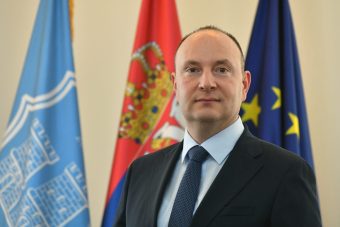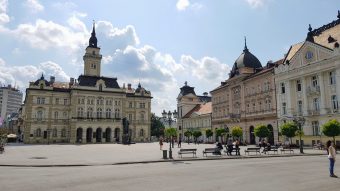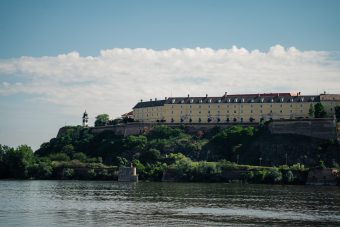
The place where European roads and railways have crossed since ancient times, better known among people as “Serbian Athens”, is adorned with a kind of classiness that is reflected in numerous cultural institutions, lowland peace, artistic sensibility, and kindness of its citizens. Last year, Novi Sad won the title of European Capital of Culture, and there is hope that it will soon be the Green Capital. We talked with the mayor of Novi Sad, Milan Đurić, about the numerous green projects that are being implemented in this city, as well as about new bridges, the Botanical Garden and the Creative District.
EP: You are committed to improving energy efficiency. What are the plans for this year?
Milan Đurić: We plan to continue implementing measures related to improving energy efficiency in 2023, and funds in the amount of 40 million dinars have been earmarked for this purpose. All the measures we undertake in cooperation with the Ministry of Mining and Energy, which are related to the improvement of energy efficiency, have been very well received by citizens.
As a strategic document, the energy efficiency program of the City of Novi Sad for 2022-2024 has a significant role in preserving and improving energy efficiency. It contains the planned goal of energy savings, an overview and assessment of annual energy needs, including an assessment of the energy properties of buildings, a proposal for measures and activities that will ensure efficient use of energy, carriers, deadlines, and an evaluation of the expected results of each of the measures that foresee the achievement of the planned goal and the funds needed for program implementation. Concrete measures and activities to improve energy efficiency are elaborated in the one-year Energy Efficiency Plan of the City of Novi Sad. Citizens’ interest indicates that they are informed about current topics and that investing in improving energy efficiency consumes less energy and does not impair the comfort of life.
IN FOCUS:
- MAINTAINING THE BALANCE AND DEVELOPING THE POWER SYSTEM
- SOLUTION FOR MAINTAINING AND EXTENDING THE LIFE OF INDUSTRIAL BATTERIES
- TAKE ME AWAY…
EP: How much have you managed to improve the area of waste management in the city?
Milan Đurić: The rehabilitation project of the existing unsanitary landfill/garbage dump in Novi Sad was completed, which determined its functioning until its closure and rehabilitation. With the beginning of the work of the Regional Center with the sanitary landfill, the closure of the unsanitary landfill will begin.

Within the project “Waste Management in the Context of Climate Change (DKTI)”, which was implemented by the City of Novi Sad and the German Organization for International Cooperation (GIZ), in cooperation with the Ministry of Environmental Protection, GIZ provided funds for design and construction compost field and hangar for the treatment of green waste collected from public areas. To improve the functioning of the compost field managed by PUC “Gradsko zelenilo” Novi Sad, a green waste crushing machine was purchased.
PUC “Gradsko zelenilo” annually collects about 5,000 tons of plant waste from city areas and diverts it to a compost plant instead of driving it to the landfill. Such compost is a high-quality organic fertilizer whose application is multiple in producing and maintaining greenery in public areas. Through this processing, biowaste is returned to the city when new greenery is planted, which means the previous waste received a new purpose and value. The principle of circular economy is fully satisfied.
Before the construction of the compost field, the collected plant waste from the city areas was mostly taken to the landfill. It created costs for taking waste to the landfill, and that waste produced greenhouse gas emissions at the landfills, which negatively affects the environment. Compost production saves more than half a million dinars per year due to the elimination of the costs of taking bio-waste to landfill.
EP: The City has been subsidizing the purchase of bicycles for several years. How is the plan to make Novi Sad a cycling city going?

Milan Đurić: The City of Novi Sad attaches great importance to the development of bicycle traffic and infrastructure and is working on adopting the best practices in this domain according to the competencies and possibilities arising from the current regulations in Serbia. In recent years, more and more people from Novi Sad have decided to use bicycles as an environmentally friendly means of transportation. In addition to benefits such as avoiding traffic jams, taking care of a parking space, and saving money and time, there is certainly also the preservation of the environment, a positive impact on air quality, and a contribution to personal and collective health. The general goal of the City of Novi Sad is to be recognizable and functional as a cycling city. The city supports this both with infrastructural development and direct incentives for the purchase of bicycles, supporting promotional and educational activities in this direction and cooperation with the commercial and civil sectors, which makes it unique and a successful example in Serbia. The result of cooperation and work on the development of bicycle traffic in the past 10 years can be seen in the stable growth of the number of everyday cyclists by almost 300 per cent (from an estimated 10,000 to over 30,000 regular cyclists in 2019, while the unofficial estimate is that there are currently over 40,000 regular cyclists in the city). Then, in the past 10 years, about 30 km of bicycle paths were built, and over 10 km were reconstructed. For the allocation of grants to citizens, in 2021 and 2022, the city allocated 38 million dinars through three contests for citizens. Today there are around 3,406 new bicycles on the streets of the city. With the support of socially responsible companies, in 2021 and 2022, 114 bicycles were awarded to the best elementary and high school students. The plan is to continue this activity in the coming years. Also, Novi Sad is the first and only city in Serbia that will encourage its citizens to buy bicycles as an environmentally friendly means of transport for the third year in a row. In 2023, 20 million dinars have been earmarked for citizens’ support in purchasing a new bicycle. In collecting information, the city regularly cooperates with the civil sector, including the organization Novi Sad’s Bicycle Initiative.
EP: In which direction will you direct the investments intended for environmental protection?
Milan Đurić: Nature in the city is extremely important for maintaining human contact with it and is necessary for creating a healthy and sustainable urban society. The city will allocate significant funds in 2023 for the maintenance of existing greenery and the planting of new tree seedlings, shrubs and feathers, flower beds and the reconstruction of lawns to preserve and improve vegetation in the City of Novi Sad territory. Bearing in mind the importance of parks, two new parks were formed and arranged in the previous period: Park near the Ranžirna station and St. Andrew’s Park. The design and technical documentation for the park near SPENS is in progress, while the design and technical documentation for the University Park in Novi Sad is planned for 2023.
Project and technical documentation for constructing the Botanical Garden complex in Novi Sad are also being prepared. The botanical garden will be built on about 4.2 hectares in the suburbs of the Petrovaradin fortress and will be conceived as an object of special importance. With the aim of forming an information base through which trends and activities related to the arrangement, maintenance and improvement of green areas will be monitored, in 2020/21, the creation of the Geographical Information System of Green Areas of the City of Novi Sad was successfully implemented. It represents the first step in forming the Cadaster of Greenery, and now we have to fill that database by entering attributes for each individual or green area. Only when all the data are entered can we talk about the greenery cadaster as a basis for the management of public green areas.
Interviewed by: Milica Radičević
Read the story in the new issue of the Energy portal Magazine ENERGETIC EFFICIENCY



